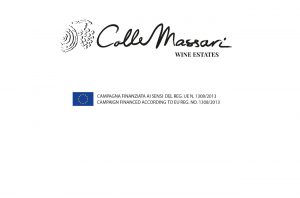The ColleMassari estate, owned by siblings Claudio Tipa and Maria Iris Bertarelli, lies just south of Montalcino in Tuscany’s bucolic Maremma region, the hilly coastal area that forms the new frontier for Tuscan wines.
ColleMassari has 1,200 hectares of land of which 10% are under vine. Existing vineyards were immediately converted to organic by Tipa after he purchased the estate and all new plantings have been organic from scratch. Bar 90 hectares planted with olive groves, all remaining land is wild habitat.
In 1999 the family purchased the 13th century castle and ancient hamlet of Montecucco, allowing the ColleMassari estate to extend its hospitality activities in a charming rural location.
Winemaking: Montecucco Sangiovese on stage
Trials showed ColleMassari’s main grape variety, the enigmatic Sangiovese, was best aged in large vats of French and Slovenian oak, rather than in smaller barriques. The bigger format, tighter-grained oak regime means Sangiovese wines retain greater typicity, freshness and longer drinking windows.
Head winemaker Luca Marrone says
“Montecucco provides Sangioveses with deeper colour than other regions. The wines have distinct spice and menthol notes too, which barrel ageing would have muted.”
The wines are fermented in a spacious, four-level eco-friendly cellar dug into a cool, rocky hillside. Its design and location allow for all work to be conducted by gravity, providing a cost-free, natural, and environmentally sensible alternative to pumping. The cedar wood roof paneling carries organic compounds that combat mould naturally.

Claudio Tipa with head winemaker, Luca Marrone
Organic viticulture
What is interesting about ColleMassari is that its range comprises smooth and even-textured wines, yet the micro-climates can be very varied. There are hot dry spots in higher altitudes, plus sunny, windier, self-draining vineyards and cooler, wetter, slower-ripening conditions on lower sites where water drains less easily.
‘To even things out we sow cover crops between the vine rows for biodiversity and as a tool to even discrepancies out,’ says Luca Marrone. ‘On higher self-draining sites, broad beans (Vicia faba) provide nutrients for the vines, protective shade for the soil, and organic matter for overall vine and vineyard health. Only every other row is cover cropped to avoid excess vigour or stress. Cover crops are not needed on mid-slope sites which can hold enough water for wild plants to thrive without human intervention. Sowing fescues on lower, more fertile sites provokes light vine stress by stealing moisture. The big win is more homogeneous ripening. You can then pick in a single pass rather than two passes, saving time and tractor diesel. And we get easier drinking wines with enhanced drinking windows. These little victories lead to bigger wins for all.’
Red wines: freshness with ageing power
Rigoleto Montecucco Rosso DOC, ColleMassari’s everyday red is made from Sangiovese for freshness, Ciliegiolo for its violet notes, especially vivid due to the sea air, and Montepulciano for staying power. This makes Rigoleto an everyday wine that is capable of ageing, too.
ColleMassari’s signature wine is its SuperTuscan, Rosso Riserva Montecucco DOC, made from 80% Sangiovese and 10% of both Ciliegiolo and Cabernet Sauvignon. The wine ages mainly in large barrels, plus French barriques for the Cabernet, for around 14 months. Bright in colour with well-judged oak, broad appeal and a wide drinking window.
ColleMassari’s flagship single-vineyard red is the Poggio Lombrone Montecucco DOCG Sangiovese Riserva, made from heritage strains or biotypes of Sangiovese. This means each individual vine is genetically similar to all the others, but all are nevertheless also naturally diverse showing slightly different behaviour.
These original Sangiovese grapes used for Poggio Lambrone, already part of the property when it was taken over by the Tipa family, have adapted well to gradual climate change, which is possibly part of the reason for the lack of any sense of stress in this Brunello-esque wine.
Poggio Lambrone’s complexity derives from traditional fermentation in open wood vats followed by at least 30 months ageing in oak barrels. This gives the wine a notable array of subtleties in terms of texture, colour, and of course, flavours and aromas.
Interestingly, all ColleMassari’s Sangiovese plantings derive from cuttings taken from Poggio Lombrone’s now fifty-five-year-old vineyards.

White wines: Vermentino kissed by the sea
ColleMassari overlooks the Tyrrhenian Sea whose buffeting winds bring out the best in the Vermentino grape.
The smooth and salty undertow in both of its white wines comes not from Poseidon but from a jigsaw of small, diverse and individually expressive plots, and the natural freshness which is imparted by having the vines at altitudes of 300 metres.
Montecucco DOC Vermentino Melacce is a deliciously engaging mid-weight dry white whose mix of yeasty savouriness and lively lemony-orange fruit makes it so mouth-watering that it is salivatingly hard to put down.
Montecucco DOC Vermentino Irisse is an off-beat one-of-a-kind bone dry Vermentino with the addition of 20% Grechetto di Todi grapes originating from neighbouring Umbria. Vermentino delivers its almost oily but layered yellow fruit richness whilst the Grechetto di Todi provides its customary fresh lemony acidity, creating mouth-watering inner tension.
Discover more about Castello ColleMassari here
Connect on: Facebook | Instagram | Twitter | YouTube |








